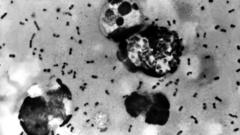In a rare and unfortunate event, health officials in Arizona announced on Friday that a resident from Coconino County has died from pneumonic plague, marking the first such death in the area since 2007. The Coconino County Health and Human Services reported that the previous case involved an interaction with a deceased animal that harbored the disease.
Historically, the plague is notorious for causing catastrophic mortality, known as the "Black Death," responsible for decimating nearly half of Europe's population in the 14th century. However, in contemporary times, cases of human plague are infrequent, with a reported average of just seven cases annually in the United States, according to the Centers for Disease Control and Prevention (CDC).
Despite the tragic loss, Coconino County officials assert that the general risk to public health remains low. "Our heartfelt condolences go out to the family and friends of the deceased," Coconino County Board of Supervisors Chair Patrice Horstman stated. To maintain privacy, they have decided not to disclose further details regarding the victim's identity or circumstances surrounding the case.
Pneumonic plague, primarily a severe lung infection caused by the bacteria Yersinia pestis, is one of several forms of plague, including the more commonly known bubonic plague, which typically results from flea bites. Pneumonic plague is particularly serious due to its potential to spread to the lungs from untreated forms of the disease, though it remains a rare occurrence today.
Symptoms for bubonic plague generally develop between two to eight days post-exposure and may include fever, chills, headaches, weakness, and swollen lymph nodes. In contrast, symptoms of pneumonic plague may present more acutely, requiring immediate medical intervention.
In light of this incident, health officials encourage the public to adopt preventive measures to mitigate exposure risks. These include using insect repellent containing DEET to ward off flea bites, avoiding contact with dead animals or infected materials, and steering clear of close interactions with symptomatic individuals, particularly in areas where recent plague cases have emerged.
As the world becomes increasingly vigilant about public health, this incident serves as a reminder of the need for continued awareness and safety measures regarding rare yet severe diseases like the plague.
Historically, the plague is notorious for causing catastrophic mortality, known as the "Black Death," responsible for decimating nearly half of Europe's population in the 14th century. However, in contemporary times, cases of human plague are infrequent, with a reported average of just seven cases annually in the United States, according to the Centers for Disease Control and Prevention (CDC).
Despite the tragic loss, Coconino County officials assert that the general risk to public health remains low. "Our heartfelt condolences go out to the family and friends of the deceased," Coconino County Board of Supervisors Chair Patrice Horstman stated. To maintain privacy, they have decided not to disclose further details regarding the victim's identity or circumstances surrounding the case.
Pneumonic plague, primarily a severe lung infection caused by the bacteria Yersinia pestis, is one of several forms of plague, including the more commonly known bubonic plague, which typically results from flea bites. Pneumonic plague is particularly serious due to its potential to spread to the lungs from untreated forms of the disease, though it remains a rare occurrence today.
Symptoms for bubonic plague generally develop between two to eight days post-exposure and may include fever, chills, headaches, weakness, and swollen lymph nodes. In contrast, symptoms of pneumonic plague may present more acutely, requiring immediate medical intervention.
In light of this incident, health officials encourage the public to adopt preventive measures to mitigate exposure risks. These include using insect repellent containing DEET to ward off flea bites, avoiding contact with dead animals or infected materials, and steering clear of close interactions with symptomatic individuals, particularly in areas where recent plague cases have emerged.
As the world becomes increasingly vigilant about public health, this incident serves as a reminder of the need for continued awareness and safety measures regarding rare yet severe diseases like the plague.






















